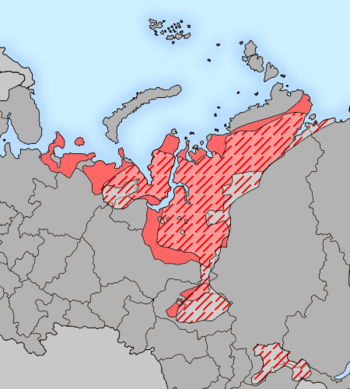- Samoyedic languages
-
Samoyedic Samoyed Geographic
distribution:Northern Eurasia Linguistic classification: Uralic - Samoyedic
Proto-language: Proto-Samoyed Subdivisions: Core SamoyedicISO 639-5: syd 
Geographical distribution of Samoyedic languages in the 17th (hatching) and 20th (continuous) centuries.The Samoyedic languages (/sæmɵˈjɛdɨk/, /ˈsæmɵjɛd/) are spoken on both sides of the Ural mountains, in northernmost Eurasia, by approximately 30,000 speakers altogether.
The Samoyedic languages derive from a common ancestral language called Proto-Samoyedic, and they form a branch of the Uralic languages. They are not a diverse group of languages, having separated perhaps in the last centuries BCE (Janhunen 1998).
Contents
Etymology
The term Samoyedic is derived from the Russian term samoyed (Russian: самоед) for some indigenous peoples of Siberia. It is sometimes considered derogatory because its etymology has been interpreted as originating from Russian: Samo-yed: "self-eater."[1] Therefore sometimes the word Samodeic[2] is suggested by some ethnologists.[1] Other interpretations of Samoyedic etymology suggest that the term originates from an expression same-edne, meaning the Land of the Sami peoples.[3]
Classification
The language and respective ethnic groups are traditionally divided into Taiga, Tundra, and Mountain groups, and further into Northern and Southern groups; these are areal rather than genealogical groupings.
- Northern / Tundra Samoyed (areal)
- Nganasan (Tavgy, Tavgi, Tawgi, Tawgi-Samoyed)
- Enets–Nenets
- Southern Samoyed (areal)
- Selkup / Taiga (Ostyak-Samoyed), divided in divergent dialects:
- Taz Selkup
- Tym Selkup
- Ket Selkup
- Sayan / Mountain Samoyed
Genealogical classifications point to an early divergence of Nganasan and (perhaps to a lesser degree) Mator, with Enets–Nenets–Yurats and Kamas–Selkup forming internal branches. (Janhunen 1998)
- Enets–Nenets
- Kamas–Selkup
Geographical distribution
At present, Samoyed territory extends from the White Sea to the Laptev Sea, along the Arctic shores of European Russia, including southern Novaya Zemlya, the Yamal Peninsula, the mouths of the Ob and the Yenisei and into the Taimyr peninsula in northernmost Siberia. Their economy is based on reindeer herding. They are contiguous with the trans-Ural Ugric speakers and the cis-Ural Komi to the south, but they are cut off from the Baltic Finns by the Russians in the west. In the east traditionally dwell the northern Turkic Yakut. A substantial Samoyed city grew up at Mangazeya in 16th century as a trade city, but was destroyed at the beginning of the 17th century.
The Southern Samoyedic languages historically ranged across a wide territory in central Siberia, extending from the basin of the Ob River in the west to the Sayan-Baikal uplands in the east. Of these languages, only the Selkup language has survived to the present day.
References
Janhunen, Juha 1998. Samoyedic. In: Daniel Abondolo (ed.), The Uralic Languages, pp. 457–479. London / New York: Routledge.
Uralic languages Finnic Sami Miscellanea Permic Ugric Samoyedic Italics indicate extinct languagesCategories:
Wikimedia Foundation. 2010.

